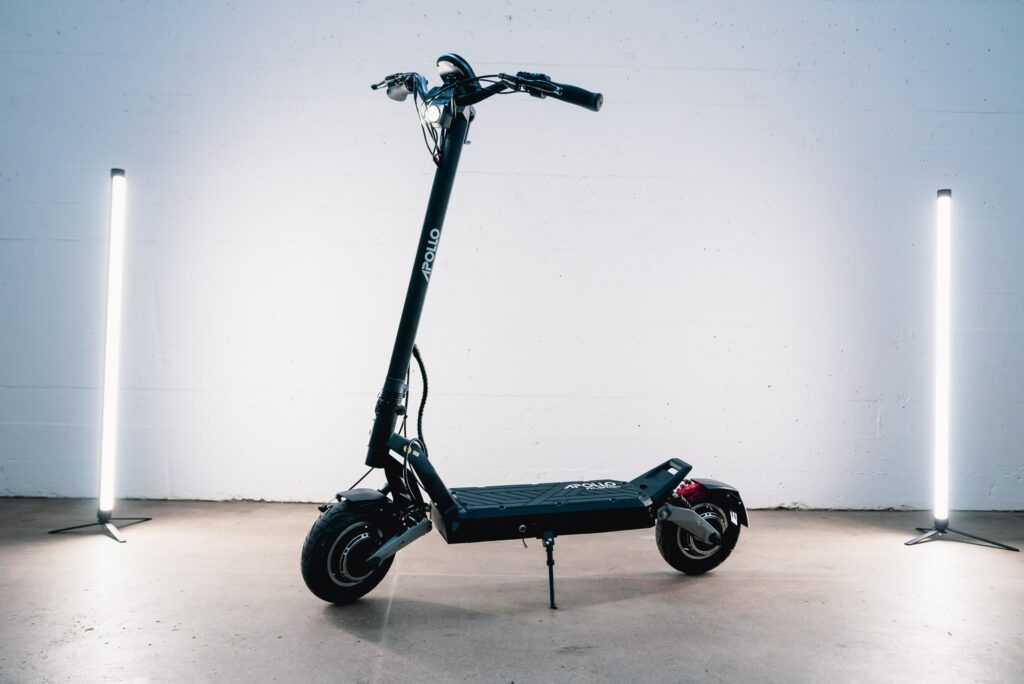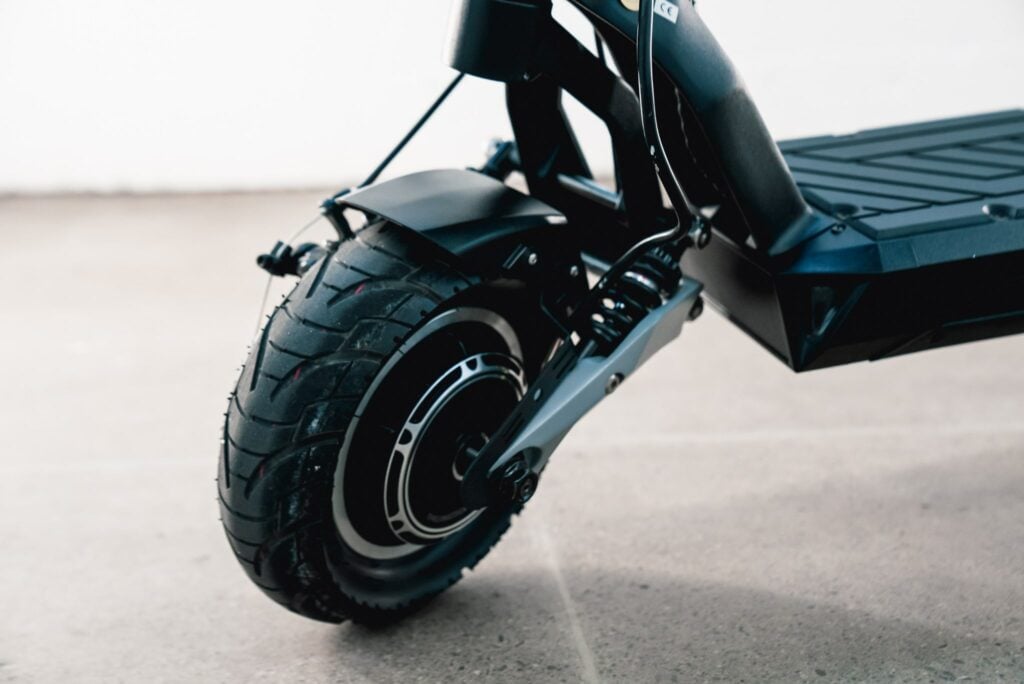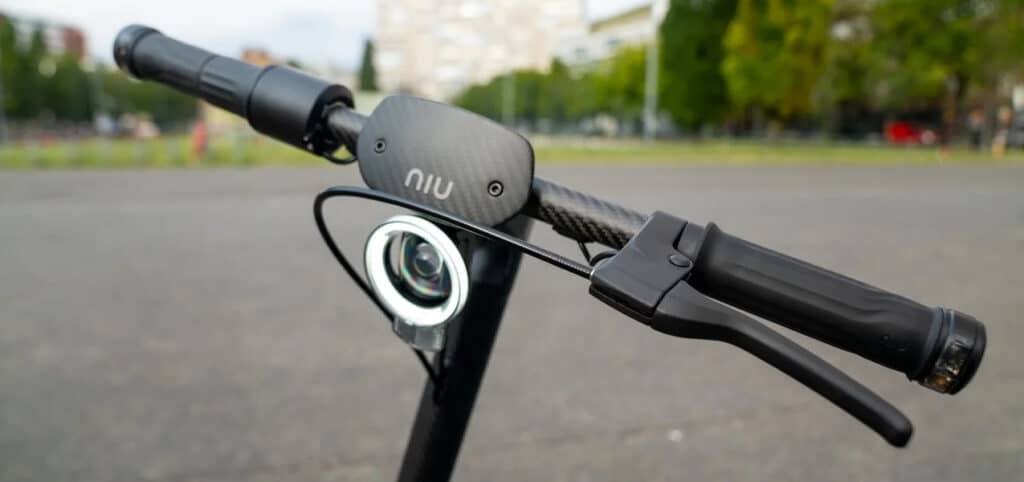The Apollo Phantom V3 is a long-awaited upgrade for existing Phantom owners, and for lovers of Apollo scooters. It is the third iteration of a scooter that has vowed to remain relevant through the changing industry dynamics–and with new firsts, like LUDO mode and an App.
Apollo Phantom V3 - $2199

Paul Somerville
March 17, 2023
Rider Guide’s Editor-in-Chief is a seasoned expert in the electric scooter industry. With a wide-ranging background that includes managing scooter warehouses, selling thousands of motorcycles, and restoring high value (+1M) European sports cars, his expertise is unmatched. Having personally tested more than 100 electric scooters, he offers invaluable insights and recommendations to our readers. We are fortunate to have him as part of our team, as his diverse skill set and extensive experience ensure top-notch reviews.



+ 4 More
Air 2022Air 2023
Apollo Phantom V3 Review
If there’s something Apollo does well, is staying relevant. And none of their scooters are more relevant than the stylish and futureproof Phantom series. We’ve called the Phantom the most upgradable scooter, and the long awaited V3 upgrade is here. You may (or may not) know the Apollo Phantom as the scooter that changed the light heavyweight scooters paradigm. Or, you might even know it as Apollo’s first in-house design.
Whatever the case, one thing stands true, and it’s that the Apollo Phantom is a significant landmark in scooter history. Apollo kept everything we loved about the V2 (obviously) and gave the V3 a thorough touch-up to keep up with other minibeasts of the day, and we’re about to dive into the details.
Whatever the case, one thing stands true, and it’s that the Apollo Phantom is a significant landmark in scooter history. Apollo kept everything we loved about the V2 (obviously) and gave the V3 a thorough touch-up to keep up with other minibeasts of the day, and we’re about to dive into the details.
PROS
Thumb Throttle With Zero Dead Zone.
Best Regen Brakes Ever of Any Scooter In Its Class
Still The Best Overall Ergonomics In Its Class
It’s The Only One Of The Three Comparison Scooters With An App
Has a High Rider Weight Capacity
CONS
Quad Shocks Are Good But Hydraulic Damping Would Make Them Even Better
Has A Little Less Performance Per Dollar Than The Comparison Scooters
We’d Love To See Tubeless Tires On The Next Generation
We Wish The Display Was Brighter.
Technical Specifications
Tested Top Speed:
65.5 km/h
Water Resistance:
IP54
Max Rider Weight:
136.4 kg
Weight:
34.5 kg
Tested Range:
45.7 km
Acceleration:
2.6 s
**Based on our independent performance tests which may differ from manufacturer’s claims.
The Apollo Phantom V3 is available in Canada from Apollo (CA).
Our content is independent, but using our links supports our hard work!
Apollo Phantom V3 Alternatives & Competitors


Mantis King GT
The Mantis King GT stands out with its top-of-the-line suspension system featuring adjustable hydraulic coil-overs both in the front and rear, delivering an incredibly smooth ride. It also boasts the longest range among its peers. However, it falls short in terms of throttle control, with a noticeable dead zone that can be a bit jarring for some riders. Additionally, it has the lowest weight capacity of the group at 265lbs
See Full Review

10+
Compared to the Vsett 10+, the Apollo Phantom V3 falls slightly behind in acceleration, speed, and range. However, it makes up for it with smoother throttle control and superior braking capabilities, outdoing not just the Vsett but all other scooters in its class. Additionally, the Phantom V3 boasts a lighter weight, a more spacious deck, and a higher rider weight capacity.
See Full ReviewApollo is probably the most recognized North American (Canadian) scooter brand. If you’ve loved scooters for a while, then you know how monumental the Phantom V1 release was.
It looked like nothing we’d seen before. The trigger throttle that had been on pretty much every high performance scooter ever, was now gone and replaced with a thumb throttle and display that was 3 to 4 times bigger than the QSS4.
It looked like nothing we’d seen before. The trigger throttle that had been on pretty much every high performance scooter ever, was now gone and replaced with a thumb throttle and display that was 3 to 4 times bigger than the QSS4.
The stem wasn’t round and didn’t wobble at all. The headlight was up high where car drivers could see it, and the light coming out of it didn’t suck. Most of all, the Phantom just felt good to ride because of the quadruple spring suspension and kick-ass ergonomics.
Apollo had taken their time (years) to gather feedback from their 15,000 consumer database and carefully integrated that feedback loop into their engineering process. A year later, after even more feedback, they released the Apollo Phantom V2, which featured 12 upgrades.
The Phantom V3 starts at $2199. It is (still) a 2400 w motor scooter, with about 3000 w peak power. The V3 is another completely in-house designed high performance electric scooter, and owners of the V2 can get the upgrade kit to transform their V2 into a V3. Other than the upgrade that everyone’s talking about (hint…LUDO), there’s a lot to expect from this new scooter. Have a look:
Apollo had taken their time (years) to gather feedback from their 15,000 consumer database and carefully integrated that feedback loop into their engineering process. A year later, after even more feedback, they released the Apollo Phantom V2, which featured 12 upgrades.
The Phantom V3 starts at $2199. It is (still) a 2400 w motor scooter, with about 3000 w peak power. The V3 is another completely in-house designed high performance electric scooter, and owners of the V2 can get the upgrade kit to transform their V2 into a V3. Other than the upgrade that everyone’s talking about (hint…LUDO), there’s a lot to expect from this new scooter. Have a look:
So What's New on the Apollo Phantom V3
The Phantom V3 has gone through a few upgrades. Let’s explore a few of them and discover what it brings to the table.
- It’s the first generation of Phantoms to come with app connectivity that provides riders with an unprecedented level of control over their scooter.
- The V3 now has a MACH 1 controller, generating an impressive 25 amps of power per motor. This upgrade not only enhances the scooter's top speed and acceleration but also delivers a smoother power distribution.
- The V3 has a dedicated brake throttle for regenerative braking. This feature allows riders to use regenerative braking alone or in conjunction with mechanical brakes, significantly improving the braking distance compared to the V2.
- It features a new throttle design, which now features larger paddles, along with a new spring mechanism, ensuring comfortable contact for the rider. The control buttons have also been enlarged, making them more accessible and user-friendly.

- Another noteworthy upgrade is the reprised display, which is larger and features an anti-glare screen and a higher refresh rate, offering riders enhanced clarity.
- Furthermore, the V3 model now includes front signals, a feature that was missing in the V2, which only had rear signals.
- Finally, the controls and buttons on the Phantom V3 have undergone a strategic rearrangement for a more functional layout(More on this in the cockpit section of the article)
Our Take: The Phantom Is Getting Way “Scarier” With Ludo Mode And Regen Brakes That Are Smoother Than Silk!
Is it Good for Bigger, Heavier Riders?
Yes, all 3 versions of the Apollo Phantom are well-suited for bigger and heavier riders. But here’s why the V3 is optimal for the big dawgs.
First, the Apollo Phantom 2023 electric scooter is rated for a max rider weight of 300 lb. Its build alone tells you that it won’t crumble under heavy weights–it’s a solid, sturdy scooter that can handle its own. It is ultra-spacious on the deck, allowing riders with larger feet to shift around comfortably.
First, the Apollo Phantom 2023 electric scooter is rated for a max rider weight of 300 lb. Its build alone tells you that it won’t crumble under heavy weights–it’s a solid, sturdy scooter that can handle its own. It is ultra-spacious on the deck, allowing riders with larger feet to shift around comfortably.
The V3 scooter has more than enough power for the bigger rider. The performance doesn’t take a crippling hit with the added weight thanks to the large 1170 wh battery and powerful 2400W motors. But, even better, the scooter’s The Apollo Phantom V3 e-scooter has an RG-certified top speed of 25.29 km/h, which is exactly 0.62 km/h faster than its predecessor, the V2.
This new 41 mph top speed is impressive, and we believe it's as fast as anyone would like to go on 25.4 cm tires. air-filled tires and quad shocks ensure that the ride is super smooth. However, heavier riders might want to add spring preload to keep suspension travel optimal for their weight.
This new 41 mph top speed is impressive, and we believe it's as fast as anyone would like to go on 25.4 cm tires. air-filled tires and quad shocks ensure that the ride is super smooth. However, heavier riders might want to add spring preload to keep suspension travel optimal for their weight.
Apollo Phantom V3 Electric Scooter Review
Acceleration
The V3's acceleration is on par with its competitors, with a 0-18.64 km/h time of 7.3 seconds in Ludo mode. What really sets the V3 apart is its new throttle system, which is not only responsive but also incredibly smooth. It's so smooth that you can cruise at lower speeds without any jerks or jolts. To further enhance the riding experience, riders can fine-tune the throttle response by selecting different ride modes (1, 2, or 3), and even Ludo mode for a more intense experience.
Top Speed
The Apollo Phantom V3 e-scooter has an RG-certified top speed of 25.29 km/h, which is exactly 0.62 km/h faster than its predecessor, the V2. This new 41 mph top speed is impressive, and we believe it's as fast as anyone would like to go on 25.4 cm tires.
When it comes to stability at high speeds, the V3 performs well without any dangerous death wobbles or instability when sustaining top speeds or letting off the throttle. Overall, while not quite as fast as some other models on the market, the V3 offers a stable ride at high speeds and an impressive top speed that will satisfy most riders' need for speed.
When it comes to stability at high speeds, the V3 performs well without any dangerous death wobbles or instability when sustaining top speeds or letting off the throttle. Overall, while not quite as fast as some other models on the market, the V3 offers a stable ride at high speeds and an impressive top speed that will satisfy most riders' need for speed.
Overall, while not quite as fast as some other models on the market, the V3 offers a stable ride at high speeds and an impressive top speed that will satisfy most riders' need for speed.
Hill Climb
One of the biggest advantages of riding a dual-motor electric scooter is the ability to climb hills as fast as you would drive in a car.
During our tests, The Phantom V3 proved its worth with its dual 2400 W motors, reaching the top of a 60.96 m 10% hill in just 8.8 seconds and outpacing the V2, by 0.3 seconds. It also reached an impressive top speed of 14.04 km/h by the end of the run.
However, while this performance is certainly remarkable, it still falls behind some of its competitors, like the Vsett 10+ and Mantis King GT, both of which clocked in at 7.5 seconds to reach the top of our test hill.
During our tests, The Phantom V3 proved its worth with its dual 2400 W motors, reaching the top of a 60.96 m 10% hill in just 8.8 seconds and outpacing the V2, by 0.3 seconds. It also reached an impressive top speed of 14.04 km/h by the end of the run.
However, while this performance is certainly remarkable, it still falls behind some of its competitors, like the Vsett 10+ and Mantis King GT, both of which clocked in at 7.5 seconds to reach the top of our test hill.
Range
The 1170 Wh battery on the Apollo Phantom V3 electric scooter still managed to impress us during our test run, clocking in a range of 45.71 km. Sure, it's not as far as the V2's range, which spanned [esg_unit 3 miles 1] longer, but that's primarily because we rode the V3 in Ludo mode the whole time. It's also worth noting that the V2 has a slightly larger battery capacity of 1216 Wh, so the difference should not come as a surprise.
In fact, among the three competitor scooters, the V3 had the smallest battery, understandably giving it the least range.
However, don't let that deter you; a range above 40.23 km is more than adequate for most rides! Plus, it's worth noting that we put the V3 through its paces on a hilly range test course, pushing the scooter to its limits. In less demanding situations – think moderate speeds and flatter terrains – it's entirely possible to approach the manufacturer's stated range of 64.37 km.
In fact, among the three competitor scooters, the V3 had the smallest battery, understandably giving it the least range.
However, don't let that deter you; a range above 40.23 km is more than adequate for most rides! Plus, it's worth noting that we put the V3 through its paces on a hilly range test course, pushing the scooter to its limits. In less demanding situations – think moderate speeds and flatter terrains – it's entirely possible to approach the manufacturer's stated range of 64.37 km.
Braking
The Phantom V3 comes equipped with disc brakes on the rear and front, as well as a powerful regenerative braking system that deserves recognition. You can choose between mechanical or hydraulic disc brakes – either way, both options still provide smooth efficiency and responsive stopping. This striking combination of braking features results in the Phantom V3 achieving a remarkable stopping distance of 2.9 m from a speed of 9.32 km/h.
Unlike most other scooters, whose regen brakes function through a simple on-or-off operation triggered by a brake light switch, the Phantom V3's variable regen system operates on a progressive scale, providing more regen brake power as you squeeze the brake lever harder. You can use the app to fine-tune the intensity regen brakes to suit your needs. Proceed with caution. Increasing the intensity too much may result in overly aggressive braking, which can compromise your safety.
With its powerful 100% regenerative brake lever, you can choose to forgo using the traditional mechanical brakes. When you engage the regen brake, it feels like a smooth, elastic force, akin to a rubber band, that is gently tugging you backwards, offering an smooth sense of control and gradual deceleration.
Ride Quality
The Apollo Phantom scooter line has come a long way from the previous generation scooters, boasting significant ride quality improvements that genuinely make a difference in the overall riding experience. These include a brand-new tire profile that makes cornering effortless, and a no-wobble stem, pistol grips, and pull-back handlebars.

So what has Apollo done on the Phantom V3 that sets it out to be so different? Variable regen brakes. Apollo have always been masters of blending regen and mechanical braking, and on the V3, they got it just right. The result is seamless, responsive variable regen brakes that enhance overall safety and control while riding. The V3 comes with a dedicated thumb brake throttle on the left-hand side for 100% regenerative braking. These brakes are so smooth you will easily find yourself not using the mechanical brakes at all.
The throttle response is as smooth as it gets from a non-sine wave controller, and that’s because of what the Mach 1 motor controller does: self-calibration. During assembly at the factory, the motor controller flawlessly calibrates itself to match the exact specifications of the motors installed on the scooter. Anyone installing the V3 upgrade kit on their V2 will get to see this automated process firsthand.
The Apollo V3 comes equipped with a Quadruple Suspension System (featuring two front and two rear spring suspensions), 25.4 cm tires, and a well-sized deck which combine to create an overall comfortable experience. The V3's suspension might not be designed for off-road adventures, but it is still highly commendable for its ability to handle the daily grind with ease. It has efficient shock absorption and vibration dampening that can take on most minor road imperfections.
Moreover, the V3 has generous ground clearance, enabling riders to easily glide over road bumps and obstacles. The tires provide excellent grip on any surface, making it suitable for street riding as well as light off-road escapades, And finally, with the Phantom scooter, you can enjoy a silent ride–the scooter’s motors are so quiet it's virtually inaudible, living up to the phantom name.
Learn More About the Apollo Phantom V3Apollo Phantom V3 Features
Portability
You might be thinking, “34.38 kg doesn't sound all that portable!" And while it's true that the V3 isn't exactly feather-light, its unique design makes it more portable than many of its competitors.

It's all thanks to the innovative quad shock design. By cleverly positioning these shocks to the sides of the wheels, the folks behind Phantom have managed to reduce the wheelbase distance, thus effectively shrinking the scooter's overall length.
The V3 also has one of the smallest folded dimensions amongst its comparison scooters, coming in at a compact 124.46 cm by 71.12 cm by 53.34 cm. What makes it even more convenient is the clever addition of a stem hook, which effortlessly latches to the deck, simplifying the carrying process.
Cockpit

Stepping into the cockpit of the Phantom V3, you can't help but notice the sleek, minimal approach they've taken with the design. Right away, your eyes will be drawn to the addition of a regenerative brake throttle conveniently situated on the left side.
Even more impressive is the decision to relocate the turn signal and light switch buttons right onto the brake throttle and accelerator, making them super easy to operate. They've also given the display a bit of a makeover, trading the hexagonal shape for a more rounded one.
To the left of the curved handlebar you have the rear brake lever and regenerative brake throttle that houses the mode button used to access settings on the display, as well the left side indicator and a bell. On the right side, and you'll spot the front brake lever accompanied by the throttle that houses a power button and the right side indicator.
The V3 now has dashboard indicators that clearly show when the signals are active. Additionally, an audible reminder has been integrated to alert the rider about the activated signals.
The V3 is the first generation of the Phantom with app control. You can either use buttons on the cockpit or the app to tailor the acceleration and regenerative brake response to your exact specifications, change ride modes, toggle lights on or off, enable zero start and cruise control and even lock your scooter for added security.
The V3 is the first generation of the Phantom with app control. You can either use buttons on the cockpit or the app to tailor the acceleration and regenerative brake response to your exact specifications, change ride modes, toggle lights on or off, enable zero start and cruise control and even lock your scooter for added security.

Lights

The Phantom's lighting package has always been impressive, but the latest upgrades bring it even closer to perfection. While maintaining its 1000-lumen high-mounted headlight and rear light that doubles as a brake light, the new model adds a much-anticipated safety feature: front turn signals.
This simple yet impactful addition ensures that drivers from the front can now accurately read your turning intentions, an enhancement on V2 models which only featured rear turn signals. The vivid orange turn signals on both ends can be spotted even in the daytime, ensuring a safer riding experience.
This simple yet impactful addition ensures that drivers from the front can now accurately read your turning intentions, an enhancement on V2 models which only featured rear turn signals. The vivid orange turn signals on both ends can be spotted even in the daytime, ensuring a safer riding experience.
Tires

This Apollo scooter has impressive 25.4 cm by 8.38 cm pneumatic tires that have been designed with a new profile to tackle corners effortlessly and assist with handling. These tires provide exceptional damping that works in harmony with the V3's outstanding suspension, ensuring a smooth ride over small obstacles.
One aspect that could elevate the riding experience even further would be transitioning from tubed to tubeless self-healing tires, similar to those implemented on their models, such as the Apollo City Pro.
One aspect that could elevate the riding experience even further would be transitioning from tubed to tubeless self-healing tires, similar to those implemented on their models, such as the Apollo City Pro.
Deck
The V3 is pretty much the standard for a good-sized deck, with the best balance between space and functionality. Measuring a comfortable 52.07 cm in length and 17.27 cm in width,, the V3 provides ample room for riders to comfortably position their feet, regardless of foot size, and experiment with various leg placements during their rides.
The V3's design also incorporates a convenient footrest towards the rear, providing additional support and usable space. Furthermore, the deck has a rubberized surface, significantly enhancing the grip and promoting stability and control during your rides. The V3 proudly showcases the iconic Apollo Phantom logo, giving you the ultimate sense of pride and identity as you ride. Lastly, with an impressive 15.24 cm ground clearance, you won't have to worry about scraping the underside of the deck on curbs.
The V3's design also incorporates a convenient footrest towards the rear, providing additional support and usable space. Furthermore, the deck has a rubberized surface, significantly enhancing the grip and promoting stability and control during your rides. The V3 proudly showcases the iconic Apollo Phantom logo, giving you the ultimate sense of pride and identity as you ride. Lastly, with an impressive 15.24 cm ground clearance, you won't have to worry about scraping the underside of the deck on curbs.

Furthermore, the deck has a rubberized surface, significantly enhancing the grip and promoting stability and control during your rides. Adding an aesthetic touch to it, the V3 proudly showcases the iconic Apollo Phantom logo, giving you the ultimate sense of pride and identity as you ride.
Lastly, with an impressive 15.24 cm ground clearance, you won't have to worry about scraping the underside of the deck on curbs or other obstacles when you're out and about.
Lastly, with an impressive 15.24 cm ground clearance, you won't have to worry about scraping the underside of the deck on curbs or other obstacles when you're out and about.
Build Quality

The Phantom V3 has an impressive, almost all-metal build. Seriously, this scooter looks like it could take a couple hundred falls and just bounce back like Iron Man.
The obvious things are a big deal–but the devil is in the details. The V3 now comes with exposed deck screws that allow you to get in there if you need to without pulling up the rubber cover. It sounds obvious until it’s not. For other scooters, getting into the guts requires a skilled hand and tons of patience. So, kudos Apollo.
The obvious things are a big deal–but the devil is in the details. The V3 now comes with exposed deck screws that allow you to get in there if you need to without pulling up the rubber cover. It sounds obvious until it’s not. For other scooters, getting into the guts requires a skilled hand and tons of patience. So, kudos Apollo.
The other small detail is the steel side stand. It is much stronger than the basic aluminum ones we are used to seeing.
Thankfully, Apollo also updated the screw-on charge port covers. They’re plastic now, so they won’t accidentally short out your port.
Thankfully, Apollo also updated the screw-on charge port covers. They’re plastic now, so they won’t accidentally short out your port.
Another favorite is the stem latch, though, as with most stem latches we recommend a quick spray of lithium grease to help keep it working quietly and smoothly.
The quad shocks don’t have any hydraulic damping, but because there are 4 of them, internal friction provides enough damping to keep the scooter from feeling too bouncy, and if you’re a heavier rider, having the springs on the outside makes it easier to add more spring preload to keep the suspension in the optimal range for your weight. Finally, if you happen to run into some rain, it’s got reasonably good fender protection . And, its water protection rating is IP54, so it’s ok for light rain.
Safety
There's no doubt that the V3 electric scooter prioritizes safety for both the rider and those around them. With its well-designed lighting system, the V3 ensures optimum visibility even in low-light conditions, making it easy for others to spot you while riding. Additionally, the built-in turn signals allow for clear communication of your turning intentions on the road, significantly lowering the risk of accidents.
The scooter's phenomenal braking system is designed to prevent lock-ups, significantly reducing the risk of losing control and wipeouts during sudden stops.
Warranty
All Apollo scooters are backed by a one-year limited warranty against manufacturer defects. And since Apollo is such a popular and established brand, you can be sure that they not only honor their warranties, but that their quality control process ensures that the scooters don’t leave production with manufacturing defects. For in-depth information on the specific inclusions and exclusions of Apollo's warranty, the best source is their official website, where you'll find a detailed breakdown of what's covered and how to go about making a claim if necessary.
Apollo Phantom V3: Review Conclusion

So who is the Phantom V3 for? It’s designed for thrill-seekers and daily commuters alike . Whether you live in a house with a garage, or an apartment building with two flights of stairs, this scooter will probably fit with your living situation, that is, if you’re reasonably fit.
The Phantom V3 distinguishes itself by focusing on enhanced comfort and finesse that provides a premium experience on your daily commute. It even has an app that allows for easy customization and performance tracking. So, if you're in the market for a light heavyweight e-scooter, make sure to include the top-notch Phantom V3 in your consideration.
Get Your Apollo Phantom V3 Scooter Today!The Phantom V3 distinguishes itself by focusing on enhanced comfort and finesse that provides a premium experience on your daily commute. It even has an app that allows for easy customization and performance tracking. So, if you're in the market for a light heavyweight e-scooter, make sure to include the top-notch Phantom V3 in your consideration.
Technical Specs Comparison
Model
Apollo Phantom V3
Vsett 10+
Kaabo Mantis King GT
Synergy Tsunami
Top Speed**
65.5 km/h
69.7 km/h
72.6 km/h
61.8 km/h
Range**
45.7 km
54.1 km
58.9 km
48.3 km
Weight**
34.5 kg
36.2 kg
33.6 kg
35.1 kg
Price
$2199
$2290
$2495
$2199
**Based on our independent performance tests which may differ from manufacturer’s claims.
Related Reviews

Our newsletter has the biggest discounts, newest scooter reviews, best how-to’s, & no spam. Unsubscribe anytime!
Find your perfect ride
We built a tool that makes it effortless for you to find a scooter perfect for your lifestyle. Filter, compare, and sort through almost every electric scooter in the industry.
jump injump in














